Amazing herps are found during a Borneo herping adventure
Borneo is a destination all herpers and wildlife enthusiasts should desire to visit, and the immense biodiversity and plethora of unique and endemic species draws travelers to its shores. Imagine my delight when my partner, Jannico, surprised me with a herp lover’s dream for our anniversary one May: four nights in Sarawak, Borneo. Our adventure began as we flew into Kuching, a surprisingly westernized Malaysian city located on the northwestern portion of the island. Jet-lagged from our red-eye flight, we hired a scooter and traveled to our first destination, the Permai Rainforest Resort, in the north of the city. We chose Permai specifically because the resort featured tree houses that sit in the forest’s canopy.
After unpacking, I spied movement out of the corner of my eye, and turned to see a pair of silvery lutungs (Trachypithecus cristatus)—a primate species that undergoes a stunning color change from bright orange as juveniles to a blue-silver as adults—feeding off the lush, coastal foliage just several feet outside our window. What a brilliant beginning to our anniversary!
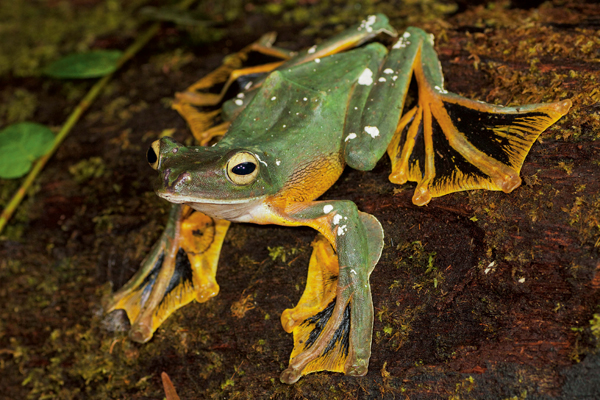
jasmine vink
Wallace’s flying frog (Rhacophorus nigropalmatus
) was on the author’s wish list for this trip, but none were found. This photo was taken during a previous trip to Borneo.
Night Hike
That night we walked along a rain forest path with our head torches scanning the trees above. Herping in Asia is far removed from the majority of Australia, where I live, and it can sometimes take a few nights for one’s body to adapt to the long jungle walks and your head being constantly craned upwards. In Australia, the majority of our herpetofauna is terrestrial, and most of my herping is done while road-cruising at night, with the odd hike. In southeast Asia, arboreal vipers are usually our target species, and they are rarely found on the road or on the ground.
We walked for hours and found a few new frog species that were posed perfectly for photos. Eventually, though, still suffering from a lack of rest and after walking uphill for what seemed hours, we were about to start the journey home when Jannico abruptly shouted the magic word: “Snake!”
A small, male Bornean keeled pit viper (Tropidolaemus subannulatus) was sitting in ambush position 15 feet above our heads, its fluorescent green coloration appearing to glow against the canopy. This species has recently been split from the Wagler’s viper (T. wagleri) complex, and all Wagler’s found in Borneo are now considered a separate species. The only way to visually distinguish them is the females; Wagler’s females are much darker with black coloration, while the Bornean keeled females lack the black. We grabbed a few photos of the viper and started the arduous journey back to our tree house, exhausted and ready for some rest. With my torch to the ground, I spotted an eye shine under the leaf litter. A small black-spotted sticky frog (Kalophrynus pleurostigma) peered back at me. We photographed it and were about to continue on our way when we spotted a familiar shape on a thin branch nearby.
It was a juvenile Bornean angle-headed dragon (Gonocephalus borneensis). Dragons are plentiful in Borneo, and the easiest way to find them is as they sleep on high, slender branches, out of reach of predators. I took a couple of photos of this one, and when I was reviewing them later I noticed something interesting. Previously, we had observed these dragons changing color and dulling down considerably after capture, but had never taken any before-and-after photos. We had left the dragon completely in situ without touching it as we photographed it, but in reviewing my photos later, I found I had been able to document a color change resulting from the stress induced by my camera’s flash. After a successful first night in Borneo we both collapsed into bed, ready for the early start that awaited us.
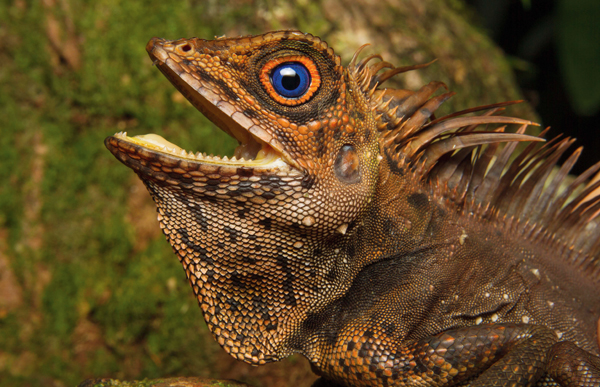
Jasmine Vink
It’s easy to see how the blue-eyed Bornean angle-headed dragon (Gonocephalus liogaster) comes by its common name.
An Odor-iffic Encounter
We woke early, eager to continue to our next destination, Kubah National Park. Famous among herpers as a frog mecca, and being a massive frog lover myself, it was a must-see for us.
On our way out of Permai, Jannico spotted a dragon camouflaged on a tree next to the path. It was a blue-eyed Bornean angle-headed dragon (G. liogaster), a new species for us and one we were hoping to find. After a few photos—and a bite to Jannico’s knuckle—we left it and jumped onto our scooter to ride toward Kubah. The park closes its gates at night to prevent poaching, so to herp there you need to stay overnight. We would have three nights to find as many herps as we could manage. After arriving in Kubah that afternoon, we hiked to the park’s waterfall, famous in Kuching. Some frogs were sitting on boulders just above the water’s edge, teasing us as they effortlessly leapt out of reach when we approached. We readied our cameras and began the grueling task of trying to get a frog to sit still long enough for a decent photo.
As I was preoccupied with this task, Jannico spotted a rather large snake on the opposite bank of the stream: a13-foot reticulated python (Python reticulatus). After capturing it, and getting thoroughly defecated upon in the process, we brought the retic to an open area for photos. Afterward, we released it back where we found it so the snake could continue its prowl into the night.
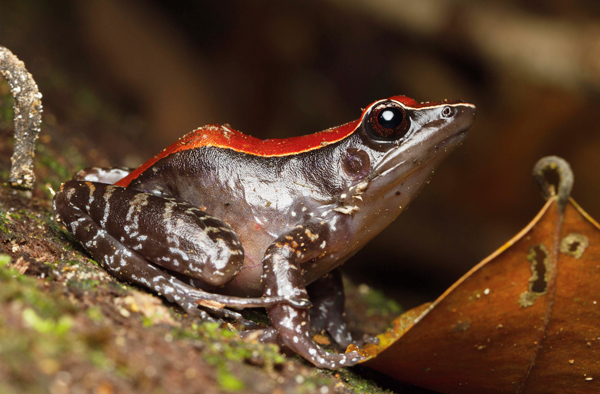
jasmine vink
The mahogany frog (Hylarana luctuosa) is one of the many amphibian residents of the frog pond in Kubah National Park.
A little smellier, but with adrenalin pumping, we began that night’s hike, stopping for a frog or dragon here and there. We had yet to find another snake. Eventually, hiking along the park’s main road, our head torches revealed something up ahead, and it turned out to be a banded coral snake (Calliophis intestinalis) that was cruising down the road. This was another new species for us, and after photographing this individual we had only walked 30 feet before we found another one. Another new species meant it was another successful night!
To The Frog Pond!
The next morning, after enjoying our usual breakfast of two-minute ramen, we planned that night’s herping adventure. We decided to road-cruise the main road that cuts through the park, as it was incredibly steep and we were not excited at the prospect of climbing it by foot. We also decided to visit the frog pond, the location of the famous Bornean Frog Race that’s held there annually. During the race, participants are given two hours to find and photograph as many amphibian species as possible. In Kubah, this number can be quite high, as the amphibian diversity is astounding!

Jasmine vink
Black-spotted rock frogs (Staurois guttatus) were found near running water during the day; at night they sleep pressed flat against large leaves.
Road cruising was quite successful, with me on the back of the scooter looking for eye shine in the trees while Jannico drove and scanned the road. Riding up to the frog pond as night was falling, I spotted another fluorescent green male Bornean keeled viper in the trees next to the road.
Our target species at the frog pond were the Wallace’s flying frog (Rhacophorus nigropalmatus) and the harlequin flying frog (R. pardalis). The flying frogs of the genus Rhacophorus use a thin membrane stretched between their toes to glide within the canopy, and they are some of my favorite frogs. We have found Wallace’s in the past, but it’s such a charismatic animal that I wanted to re-photograph some.
Unfortunately, we ended up missing out on the Wallace’s, but we did find many colorful harlequin flying frogs, another new species for us. One even “flew” for us, from the top of the canopy, over our heads and into the pond below.
Surrounding the pond were large file-eared frogs (Polypedates otilophus), and an eye shine on the path revealed our main frogging goal for the trip: a long-nosed horned frog (Megophrys nasuta). I had missed out on this enigmatic and distinctive animal on our first trip to Borneo, so naturally I was thrilled to find this one.
Driving back down the incredibly steep main road, I spotted another male Bornean keeled viper, and Jannico spotted an agile, dark-colored snake in the road ahead. Excitement got the better of him, and he jumped off the moving scooter, leaving me on the back with my feet unable to reach the ground. Myself, the scooter and our camera gear skidded on the uneven road, narrowly avoiding a fall into the deep ditches on either side.
Jannico made it up to me by presenting a juvenile equatorial spitting cobra (Naja sumatrana). We had previously found Javan spitting cobras (N. sputatrix) in Bali and on Komodo Island, so we were excited to add this new species to our list of sightings.
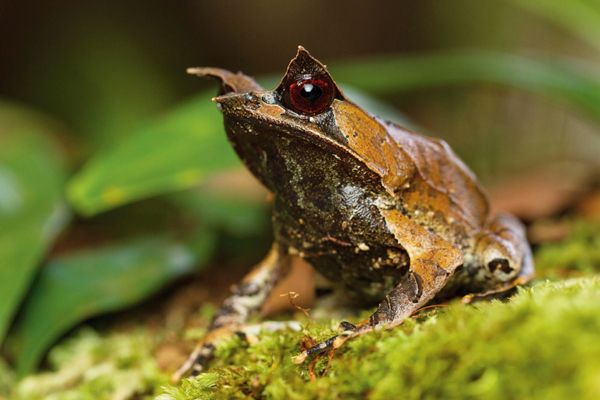
jasmine vink
One of the author’s favorite finds of the trip was the long-nosed horned frog (Megophrys nasuta), which turned out to be plentiful.
The other spitting cobras we have found were adults and were more defensive, making for fantastic photos. They did spit venom, but it was more like a light spray—nothing like the African species that expel a precision jet of venom. The equatorial spitting cobra didn’t spit at all, and after a challenging photo session we let it go on its way and we continued on ours.
We decided to try the lowest and easiest track in the park, as the others we had taken were quite high up, and as we were walking along we were greeted by a keeled rat snake (Pytas carinata) curled in a thicket in the middle of the path at eye level. It was in shed, and because this species is notoriously difficult to photograph—they’re large (up to 13 feet), agile and flighty—I took just one in situ photo before we left it to go in search of other reptiles.
We didn’t find any other snakes on this track, but we did find numerous Bornean green-eyed cat geckos (Aeluroscalabotes cf. dorsalis). Ultimately, this would be the only gecko species we photographed on this trip. We found many round-eyed (Cnemaspis) and bent-toed geckos (Cyrtodactylus), but they were so common we kept putting off taking any photos of them. It wasn’t until we returned home that we realized we didn’t have a single one! The cat gecko was another new species for us, but finding one with an original tail turned out to be too challenging. Geckos have such strong eye shine they are easy to find in the thick forest. If only snakes were so easy!
Walking back along the track toward home, I spotted a dragon sleeping on a branch. It was a female Bornean angle-headed dragon, and the most stunning we’ve seen. The bright red and yellow patterning on its body made it appear as if the lizard was on fire. We found the dragon abundance and diversity astounding, and managed to photograph three Gonocephalus species over four nights.
Island Exploration
One animal I was disappointed to miss during a previous trip to Kalimantan was the proboscis monkey (Nasalis larvatus). Happily, one of the best places in the world to see this endangered species is in Bako National Park, located north of Kuching. I made it very clear early on that a visit to Bako was on our must-do list!
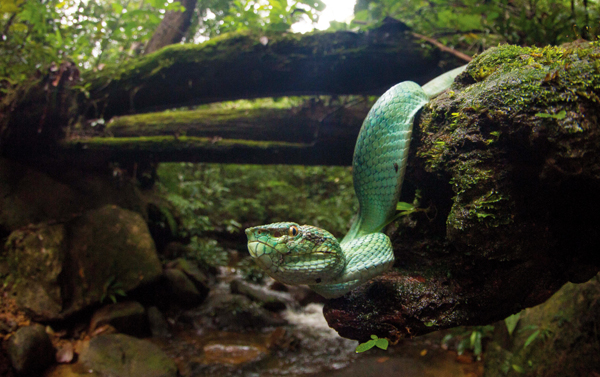
Jasmine Vink
Rocky streams in the rain forest seemed to be the preferred habitat of the Bornean keeled viper (this is a female).
The park is only accessible by boat. Upon arrival, carrying our bags and camera gear above our heads, we waded to shore with eyes peeled for signs of movement in the trees. After registering at the information center, we followed the staff’s advice and decided to take a 2-mile walk to the beach—one that was supposed to be fantastic for proboscis monkeys.
It was midday, and the sun and humidity were nearly unbearable. Wishing we had brought more water, we hiked through the rain forest and, dripping with sweat, arrived at the beach without having seen a single primate. Disappointed, we chatted with a local guide who informed us the best place to see any wildlife is around the information center. A bit annoyed at our pointless “swim” through the forest, we headed back. After a taxing journey, we returned to see a group of people huddled around a tree. We joined them to find a male proboscis monkey 15 feet up, drifting in and out of sleep. We had found our holy grail of Bako only meters from where we had waded off the boat!
The guide we had chatted with earlier appeared and told us he would be happy to show us where a resident viper could be found. We followed him to find a gorgeous female Bornean keeled viper, camouflaged perfectly among some green foliage.
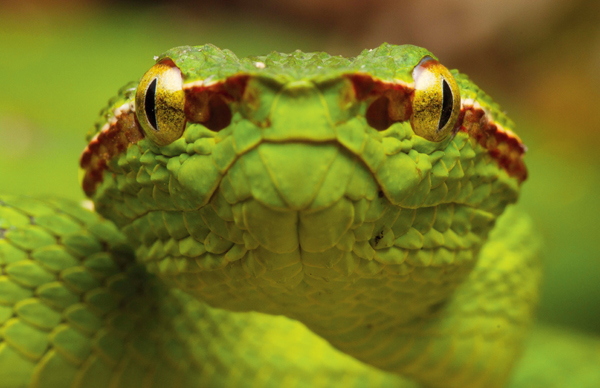
jasmine vink
Many Bornean keeled vipers (Tropidolaemus subannulatus) were encountered.
Bornean keeled vipers are sexually dimorphic and it is visually very easy to distinguish the sexes. The males are small in stature and bright green with small red rosettes along the back and a red stripe across the face. The females are much larger and stockier, ranging in color from a very light pastel green to the same bright green as the males, with blue or red stripes. This was our first female of the trip, so we were excited to photograph her. She was exceptionally well behaved and very placid, unlike the next female we would find later.
As we walked back to the boat, the guide pointed out a colugo (Cynocephalidae sp.), a species of flying lemur, sleeping high in a tree, its patterned fur blending with the bark of the tree. It was great to see one clearly during the day, and to be able to get some photos of this charismatic animal.
Final Night
After Bako, we made it back to Kubah just in time for lock out. We had our usual two-minute ramen dinner, chugged a Red Bull and embarked upon our last night hike in Borneo.
Back on the scooter, we repeated our routine of me looking for eye shine and Jannico scanning the road. We traveled higher in elevation than previously, to over 1,000 feet, but came up empty handed. On the way back down, though, I spotted a large viper iridescent against the surrounding habitat.
Hoping for a Sumatran viper (Trimeresurus sumatranus) it instead was a stunning female Bornean keeled. Her patterning was vastly different than that of the female at Bako, more pastel and almost blue. We retrieved her for photos, dangling dangerously over a steep drop, but decided to wait until the morning when the vipers are supposed to be more relaxed. This girl was striking at everything with her mouth open, the complete polar opposite of the calm individual from earlier.
Still having only found this single viper species, we hiked down a creek bed in search of Sumatrans. Later, after a long and difficult walk over slippery rocks, we admitted defeat and decided to hike down a mapped trail instead. It started raining lightly, and we didn’t think much of it until the heavens opened up. We ran for cover under a boardwalk, positioning some large palm fronds over the top to cover the cracks and protect our cameras. We decided to wait it out, as there had been no rain forecast for tonight and we assumed it would be a short shower. Huddled under the boardwalk, slowly getting wetter, we began to hear the sound of frogs calling.
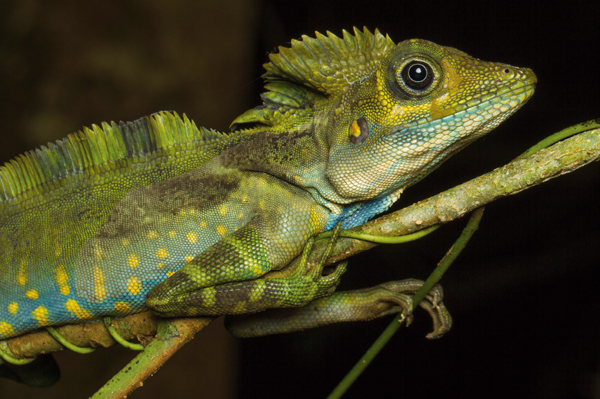
jasmine vink
This giant forest dragon (Gonocephalus grandis) was found perched on a thin branch at eye level.
With our head torches pointed in front of us, we witnessed the ground coming alive with amphibians. The noise became deafening, and a long-nosed horned frog hopped onto a rock right next to my head and stayed with us until we were forced to leave. It was the most magical experience of our Bornean adventure.
When it became clear this was not a short shower, we retrieved our flimsy disposable ponchos, tried our best to protect our camera gear, and ran through the dense jungle back to the wooden chalet where we were staying. Luckily, our camera gear remained dry, though we were drenched from head to toe. It would be a fitting end to our latest Borneo adventure.
We woke early the next morning to photograph and release our cranky viper. Even during the day, it was leaping off branches at us with mouth open. She had scarring on one side of her face and down her body, signs that she had lived a hard life. After our photos we drove back to where we found her and released her.
We bid Kubah a sad goodbye. Our four nights in Borneo were not nearly long enough, but we had an amazing and memorable first anniversary, from getting defecated on by pythons and crashing scooters to the sheer thrill of finding animals we had dreamed for years of finding. Our shared passion for reptiles, wildlife and photography brought us together, and I’m sure will take us to some of most remote and beautiful parts of the world.
Jasmine Vink is an amateur field herper and photographer based in southeastern Queensland, Australia. Her passion for wildlife, and herps in particular, has taken her across Australia and the world, as well as earning her an ecology degree at the University of Queensland.


